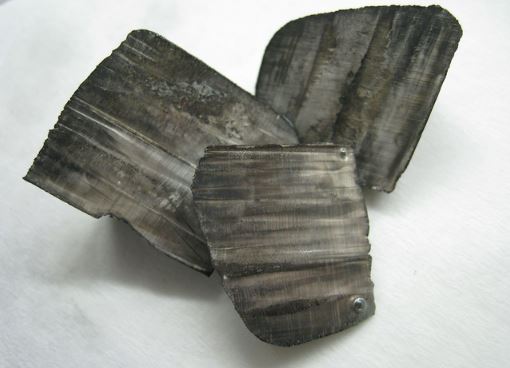Lithium in spotlight with Nemaska, Advantage news

Lithium, photo: Dnn87, CC BY 3.0
By Peter Kennedy

News of a $400 million financing package for a Quebec mine and processing plant put lithium firmly back in the spotlight Wednesday May 23.
Nemaska Lithium Inc. [NMX-TSX; NMKEF-OTCQX; NOT-FSE], a leading Canadian player in the lithium exploration and development field, is raising the funds to support commercial development of its Whabouchi lithium mine and Shawinigan electrochemical plant.
If all goes according to plan, the company hopes to begin commissioning of the Whabouchi Mine by the second half of 2019. Commissioning of the electrochemical plant would being during the first half of 2020.
Nemaska was the most actively traded stock on the TSX Wednesday with over 10.5 million shares changing hands before lunch time.
But it wasn’t the only lithium company making news on Wednesday.
Advantage Lithium Corp. [AAL-TSXV; AVLIF-OTCQX] was also active after the company released an updated resource estimate for its flagship Cauchari Project in Jujuy, Argentina. The company said drilling has increased the inferred resource to a volume of approximately 1,200 million cubic metres of brine at average grades of 450 mg/l lithium and 4,028 mg/l potassium for 3.0 million tonnes of Lithium Carbonate Equivalent.
The company said the updated estimate will form the basis for a preliminary economic assessment scheduled for completion in the second quarter of 2018.
Advantage Lithium shares rose 3.67% or $0.04 to $1.13 on Wednesday on volume of 740,762 shares.
The company is focused on developing its 75%-owned Cauchari lithium project in a joint venture with Australia’s Orocobre Ltd. [ORE-ASX]. The project adjoins the Olaroz properties, where Orocobre has a newly commissioned lithium operation, and flanks the Cauchari-Olaroz project of Lithium Americas Corp. [LAC-TSX] and SQM [SQM-NYSE].
Advantage also owns a 100% interest in three additional lithium exploration properties in Argentina. They are the Antofalla, Incahuasi and Guayatayoc projects.
Brines (in salt ponds, or salars) and spodumene (hard rock) represent the two main sources of commercial lithium production.
Investor interest in this sector is tied to the fact that lithium is a key ingredient in the production lithium-ion batteries used to manufacture electric vehicles.
Analysts agree that the booming electric vehicle market will dramatically boost the demand for battery quality lithium.
These optimistic forecasts help to explain why lithium carbonate prices have jumped to around US$18,000 per tonne from US$6,450 per tonne in early 2015. Lithium hydroxide has been trading at around US$18,500.
However, published reports say analysts at Morgan Stanley, for example, are less sure about the direction of prices in the near term. Some fear that prices could be dampened by a flood of new production.
Lithium chemicals prices are largely set by contract negotiations between producers and customers.
The two main lithium products for the production of lithium-ion batteries are lithium carbonate and lithium hydroxide. Lithium carbonate is mostly produced from concentrated lithium chloride brines in Chile and Argentina, but is also produced from lithium spodumene concentrate conversion in China.
Until recently, lithium carbonate has been the focus of many producers for battery applications.
However, this is about to change, analysts say.
“Supply of lithium hydroxide, which is also a key battery cathode raw material, is tighter than lithium carbonate at present. It is a more niche product than lithium carbonate, but is also used by major battery producers that are competing with the industrial lubricant industry for the same raw material,” said Benchmark Mineral Intelligence in a report that was posted on the Nemaska Lithium web site.
After numerous studies and working in consultation with industry experts around the world, Nemaska Lithium said it made the strategic decision to move forward with lithium hydroxide as its main product offering.
Power Metals Corp. [PWM-TSXV; PWRMF-OTC; OAA1-FSE] is taking a similar approach its flagship Case Lake Project in northeastern Ontario.
Having outlined five pegmatite dykes on the Case Lake property, the company is planning to complete a 15,000-metre drill program this year. “The upcoming drill programs are designed to increase known mineralized zones as well as find additional high grade zones like the one at our Main Dyke,” the company has said.
On Wednesday, Power Metals shares eased 3.16% or $0.015 to 46 cents. The stock is trading in a 52-week range of 25 cents and 88 cents.
Meanwhile, investment firm Cantor Fitzgerald recently launched coverage of Advantage Lithium with a buy rating and a target of $2. Cantor Fitzgerald said catalysts that could drive the stock price in the near term include a Preliminary Economic Assessment, a Phase 3 drilling program scheduled for the second half of this year, and a definitive feasibility study due to start in the first quarter of 2019.
In a unique arrangement, Dajin Resources Corp. [DJI-TSXV; DJIFF-OTC; A1XF20-FSE] has signed a joint venture agreement with Geothermal Development Associates, of Reno, Nevada. Geothermal develops geothermal resources for electrical generation and holds geothermal leases that overlap Dajin’s placer claims in the Teels Marsh valley, Nevada. Geothermal and Dajin will share exploration data with the goal of supporting development of a lithium-brine extraction facility as well as the development of a geothermal plant for electrical generation and the production of direct-use thermal water.
